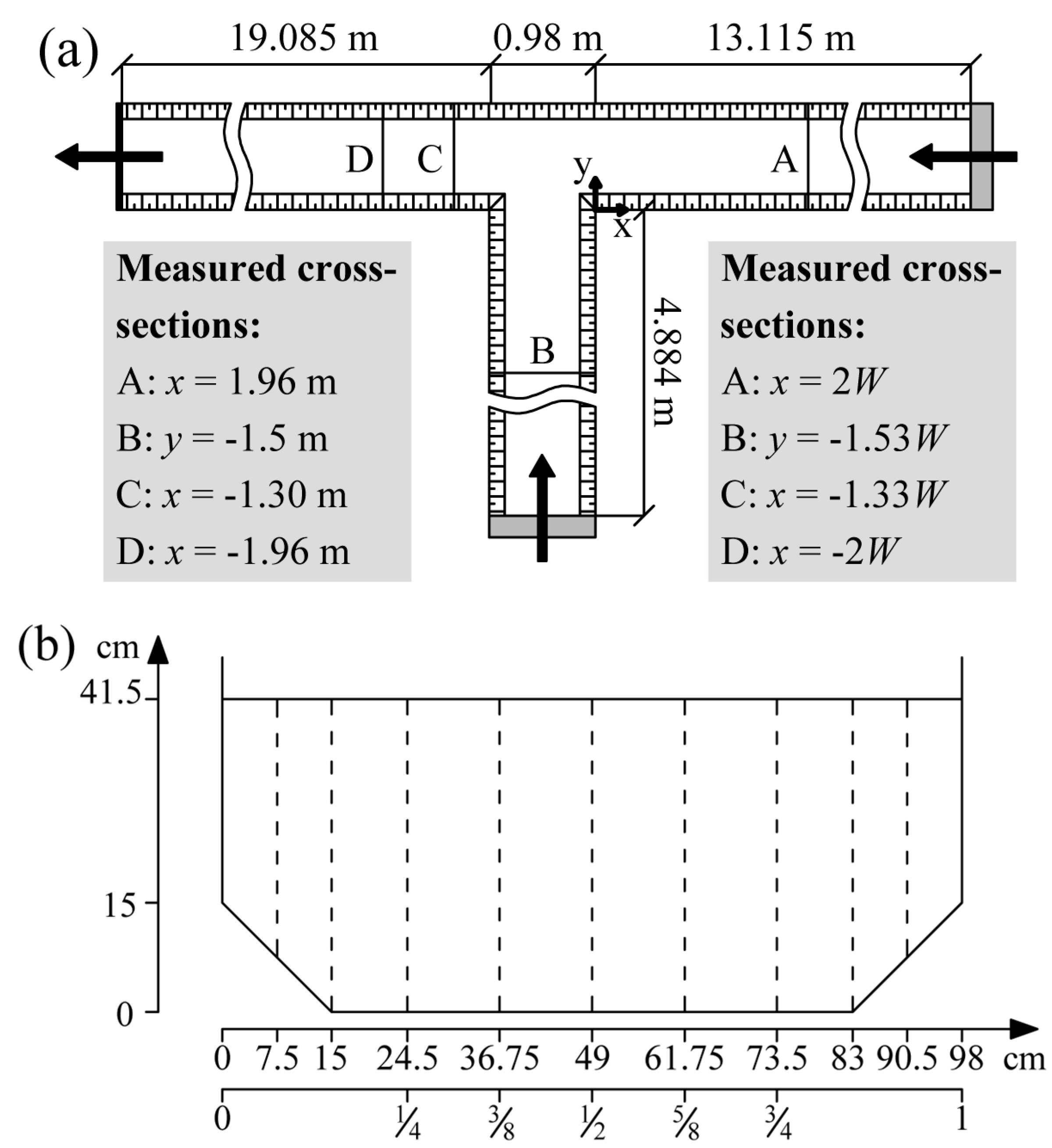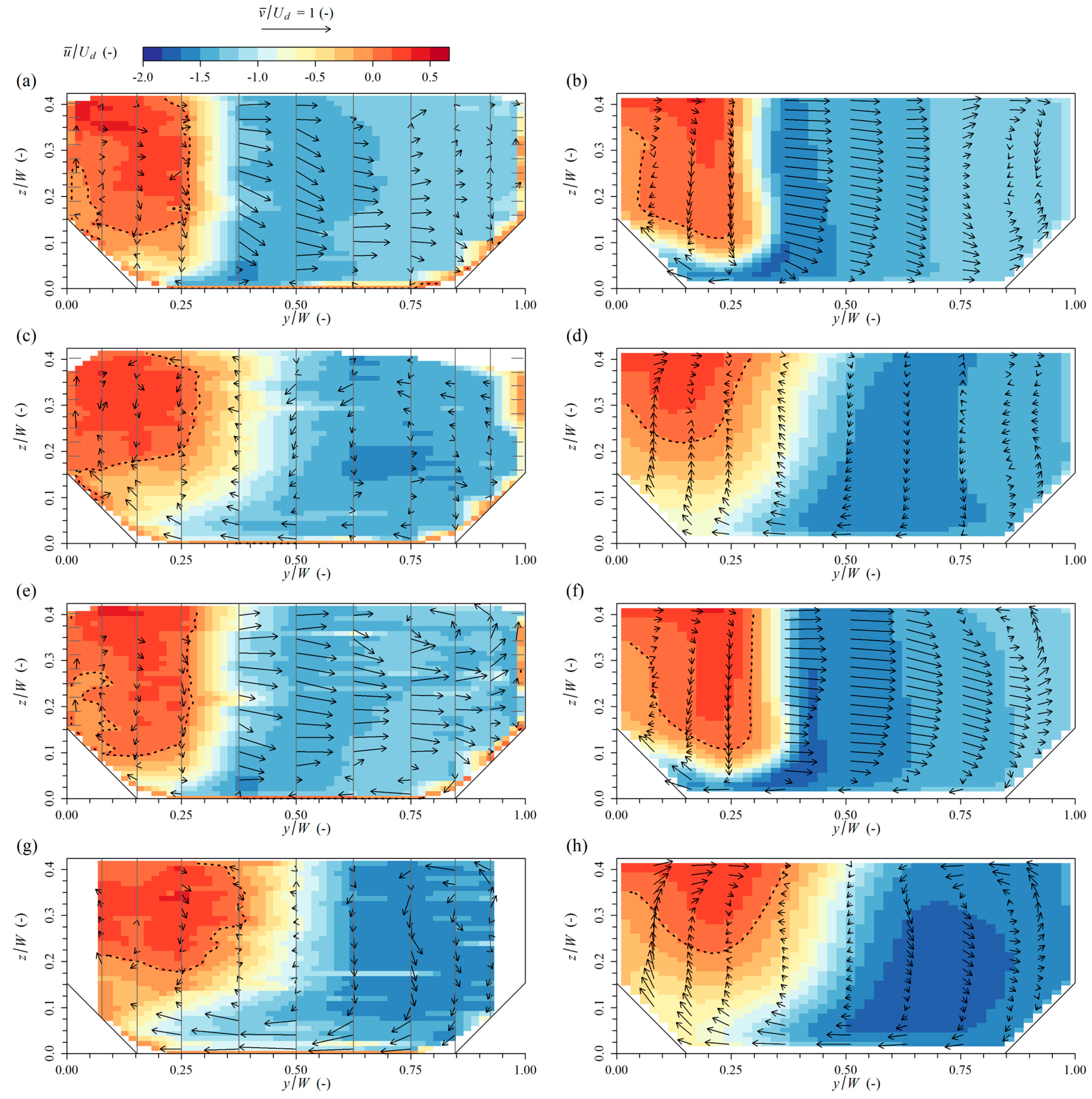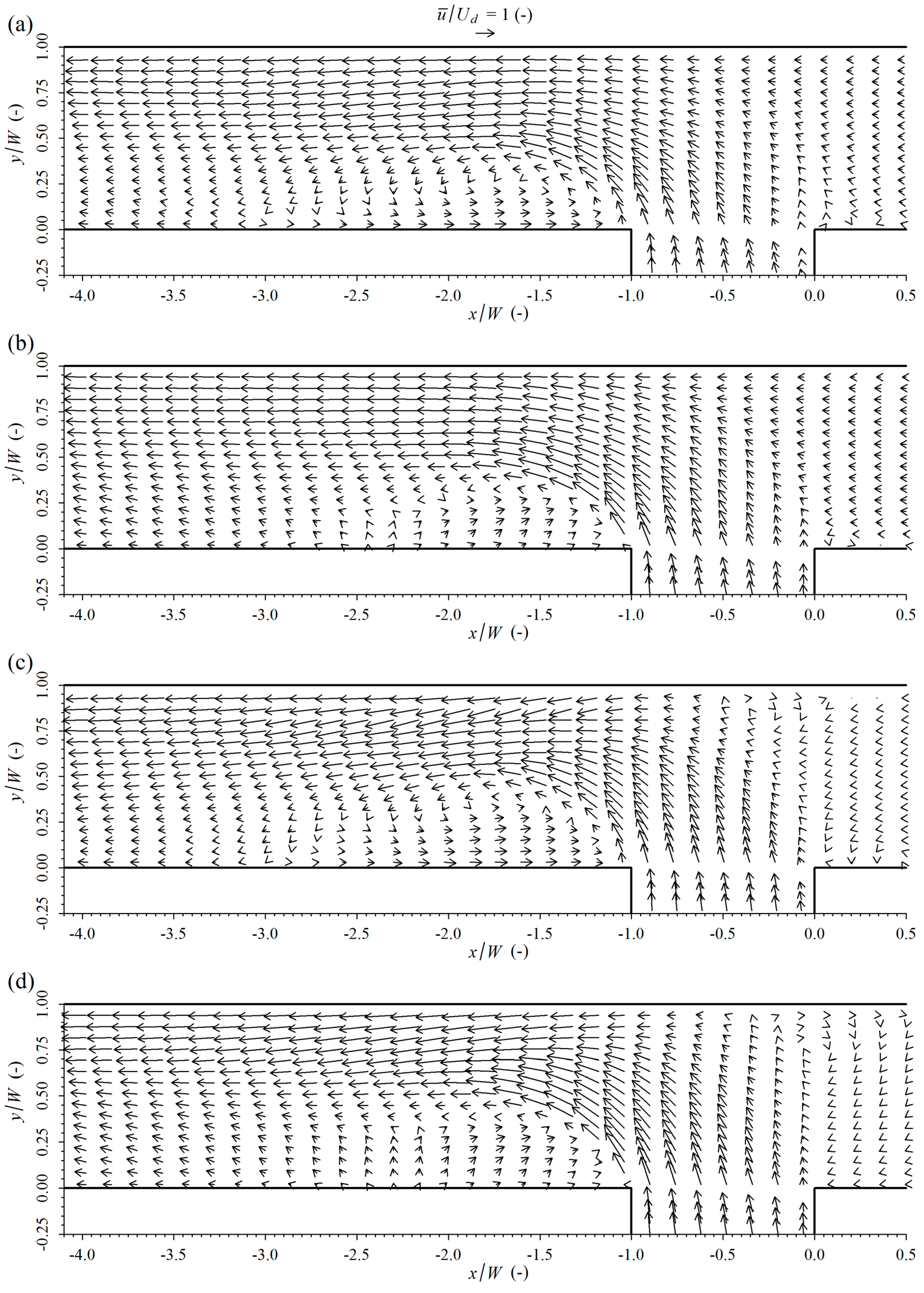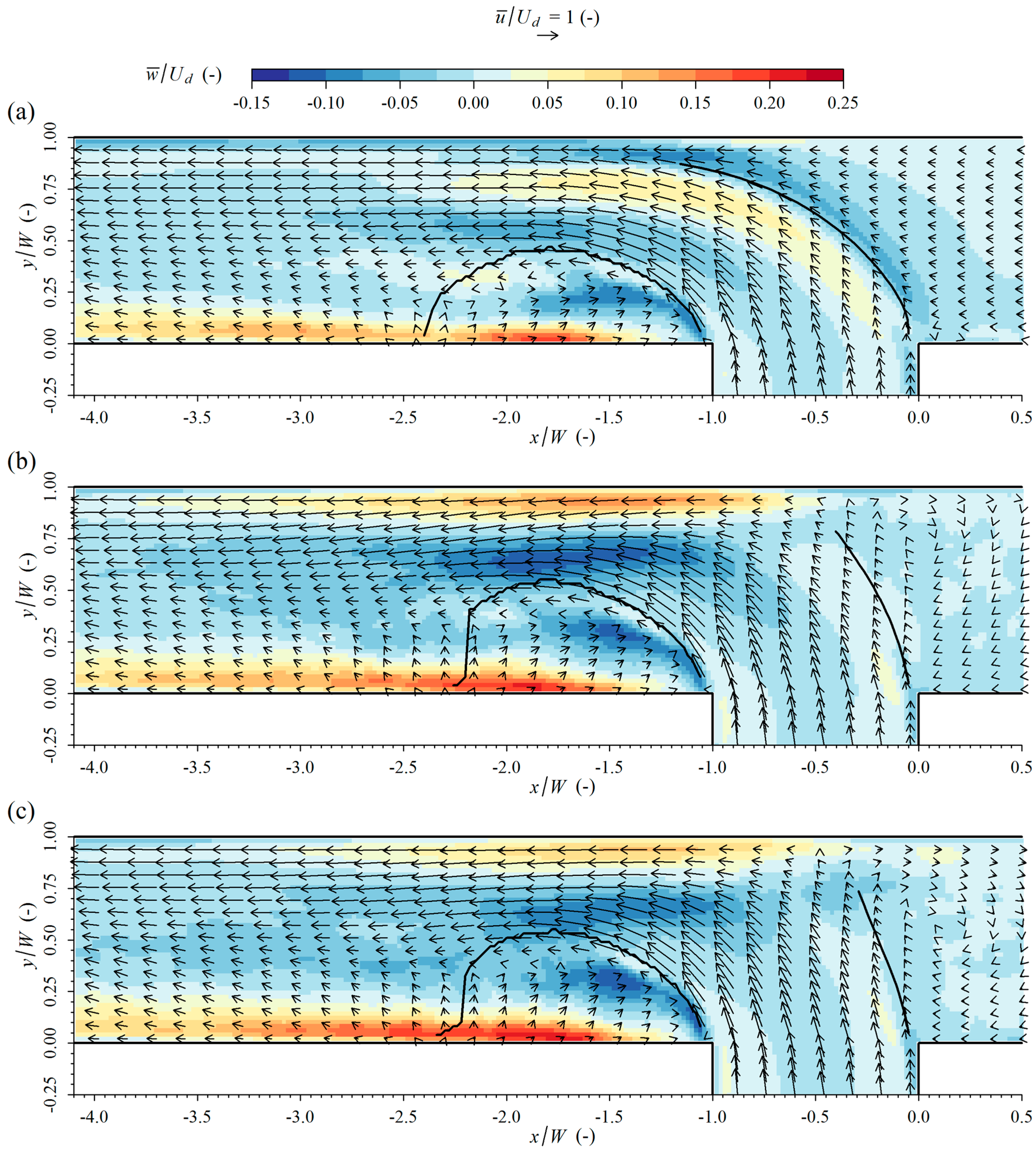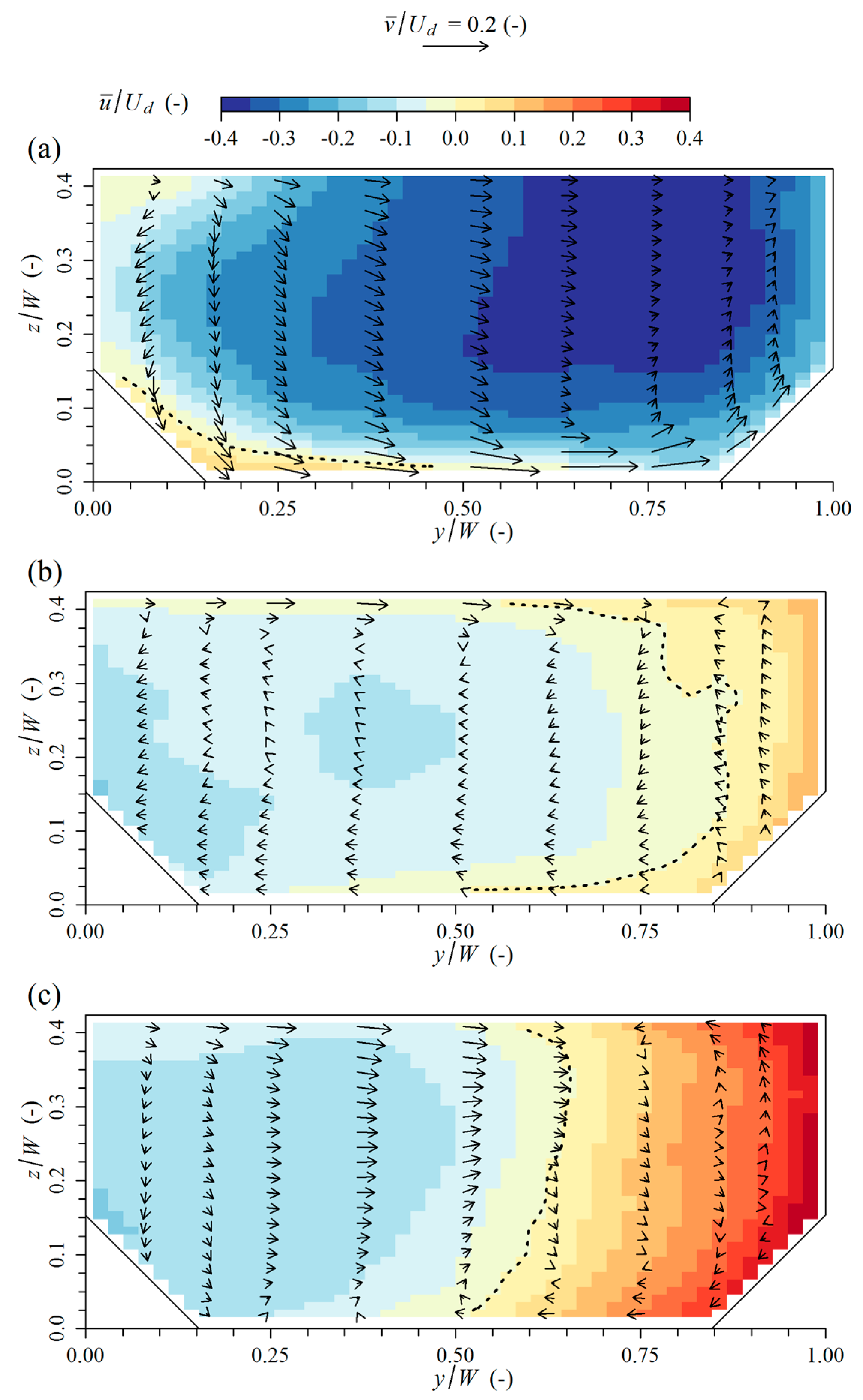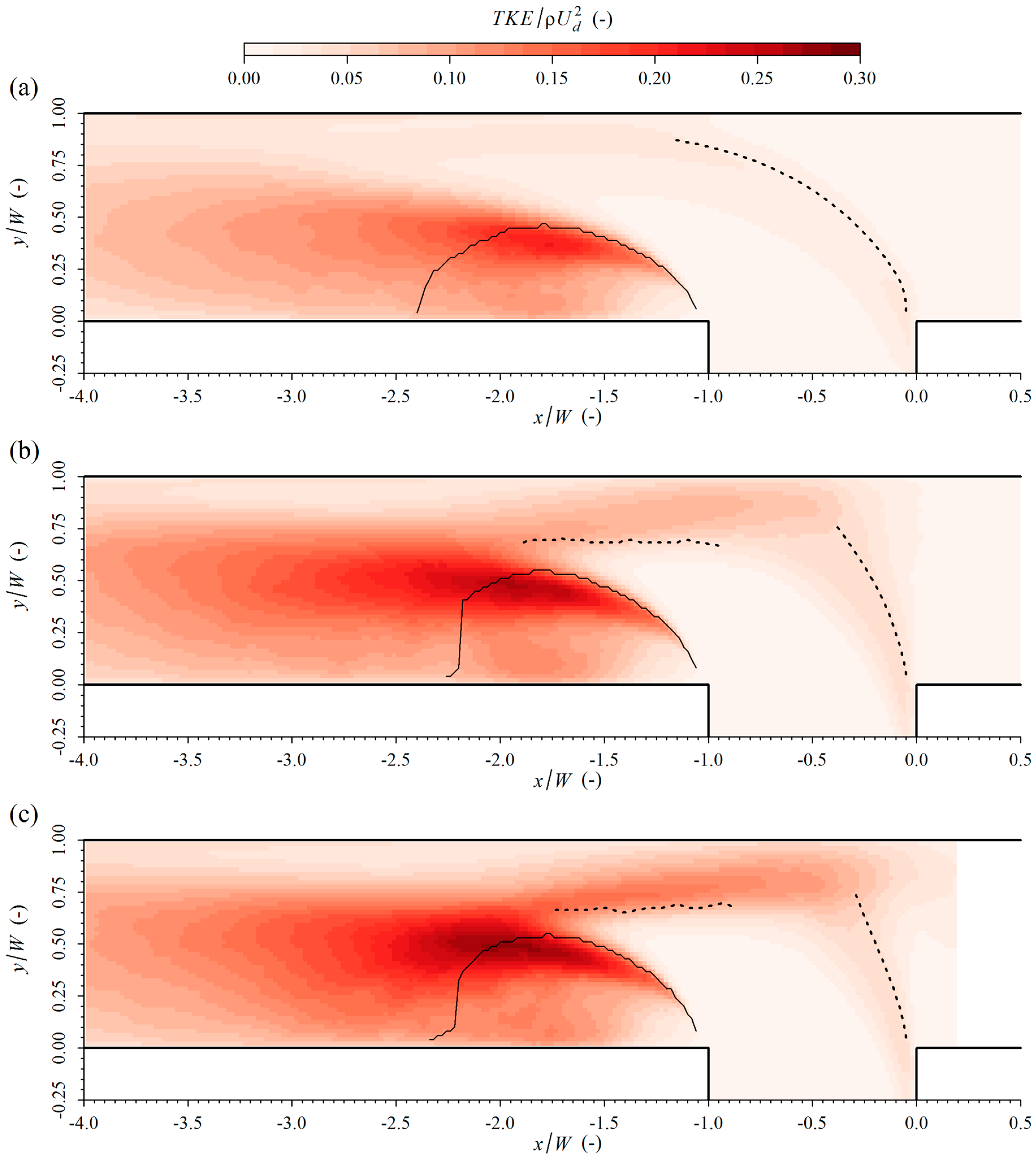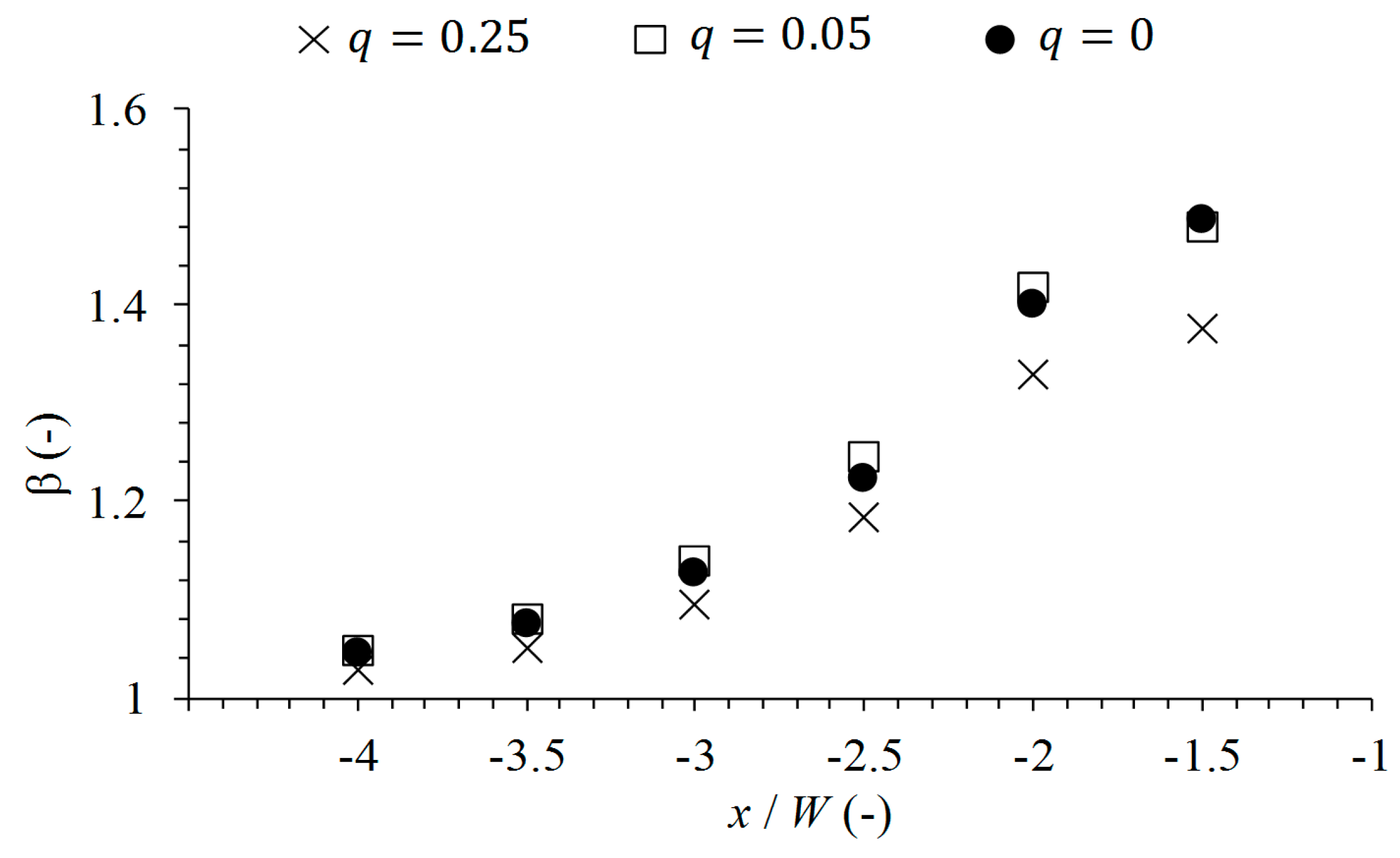1. Introduction
Confluences of open channels are important elements in hydraulic networks of rivers and man-made canals. The associated flow patterns govern the transport of solutes and sediments in the network and influence the water levels of the incoming channels. The flow features that appear in an open channel confluence can be conceptualized as follows (
Figure 1 after Best [
1]): At the point where the two incoming flows meet, a stagnation zone develops,
i.e., a zone of reduced flow velocity. From the stagnation zone, a mixing layer departs, which delineates the merging streams. At the downstream junction corner, the tributary flow may detach, causing the formation of a separation zone. Next to the separation zone, the merging flows passing through a narrowed cross-section are contracted, leading to increased velocities.
Figure 1.
Conceptual model of an open channel confluence (after Best [
1]).
Figure 1.
Conceptual model of an open channel confluence (after Best [
1]).
From the very beginning of laboratory research on confluences, starting with Taylor [
2], the ratio of incoming discharges has been recognized as a key parameter [
1,
2,
3]. However, laboratory research was mainly performed with discharge ratios in the range of
, at least for the case of asymmetrical confluences with a fixed concordant bed and subcritical flow throughout [
12]; the type of confluence that will be further considered in this paper. In the above-mentioned equation, the discharge ratio
q is defined as the ratio of upstream to downstream channel discharge (see
Figure 1):
Although it is known that the three-dimensionality of the flow increases with a decreasing discharge ratio,
i.e., when the tributary becomes dominant, indications of the flow features at
q < 0.1 are scarce. For example, Webber & Greated [
3] observed a decreasing accuracy of their theoretical model at lower
q. Gurram
et al. [
6] were the first to provide a qualitative view on the case where
q = 0 (
i.e., all flow coming from the tributary) by means of photographs. They noted the significant impact of the tributary flow on the opposing wall, and alluded to flow in a mitre bend. The uniqueness of
q = 0 has also been demonstrated for transcritical flow [
4], where a local maximum in the water height at the opposing wall is found when
q = 0, a phenomenon that is absent at the other investigated discharge ratios. Moreover, the flow field indicates inflow from the confluence area into the upstream channel when
q = 0. For subcritical flows, Shumate [
8] reported that the case
q = 0.083 (
i.e., the case with the smallest discharge ratio amongst his experiments) did not follow the trends deduced from the cases with higher discharge ratios. He reported the separation zone was shorter than expected due to the reflection of the lateral flow in the upstream channel. All the foregoing elements offer evidence that distinct flow features are present at sufficiently small discharge ratios. However, no systematic study of these patterns has been undertaken.
As preliminary research, Schindfessel
et al. [
12] experimentally compared two discharge ratios,
q = 0.25 and
q = 0.05, in a 90° angle confluence flume and found some particularities at the small discharge ratio. The impinging tributary flow led to a recirculating eddy in the upstream channel, as well as to changes in the helicoidal cells.
Field-based research also acknowledged the importance of the discharge ratio (e.g., [
14,
15]), not only on time-averaged flow, but also on intermittent features [
16,
17]. According to the literature overview provided by Leite Ribeiro
et al. [
18], the only morphological study including
q < 0.1 was provided by Rhoads
et al. [
15]. These authors found that low discharge ratios are associated with a distinct bed topography, whereby the scour hole is located close to the opposing bank (seen from the tributary), leading to erosion of that bank in the long term. This is caused by the tributary flow protruding far into the confluence zone. Though this confirms the importance of small discharge ratios, values of
q < 0.1 occurred only a limited number of times within the time period covered by the measurements. Hence, the aforementioned results cannot be linked to a specific discharge ratio. For the sake of completeness, Best [
1] monitored a flood event in which
q decreased to less than 0.1, resulting in an increased penetration of the tributary avalanche into the confluence, and an erosion of the upstream channel avalanche.
In summary, the knowledge of flow patterns when the tributary discharge is dominant, say
q < 0.1, is not that well developed, neither in laboratory nor in field experiments. Nevertheless, such discharge ratios can be present in the case of confluent rivers with a distinct hydrological regime [
1,
15]. Other examples of confluences with extreme discharge ratios pertain to more engineered situations, e.g., the junction of a river and a channel bypassing a weir or a navigation lock in the river (meant for spilling the river discharge or for fish migration purposes), or networks in a sewer or drainage system.
Recognizing the knowledge gap, this paper offers a systematic study of the evolution of the flow patterns at a (specific) open channel confluence when the tributary discharge becomes increasingly dominant. Questions that arise are:
What happens at extremely low discharge ratios when the tributary flow impinges on the opposing wall? How does this influence the small inflow coming from the upstream channel?
Are known trends regarding flow patterns in the function of the discharge ratio confirmed at limiting small discharge ratios?
Does the small discharge ratio influence the position of the mixing interface and possible helicoidal cells?
To what extent does the small discharge ratio influence possible intermittent flow features?
In order to elucidate these issues, a 90° confluence with a fixed concordant bed was studied by means of numerical simulations that are (partially) validated by laboratory experiments. Though the focus is on a detailed study of velocity fields, both engineering and earth sciences may benefit from an improved understanding of flow features at confluences in which the tributary discharge is dominant.
2. Laboratory Experiments for Numerical Model Validation
Experiments are carried out in an existing 90° angle confluence flume with concrete walls. All the channels of the confluence are horizontal, concordant and have a chamfered rectangular section with a width
W of 0.98 m, as depicted in
Figure 2. Note that the chamfered cross-section is typical for rectangular sections made with
in situ cast concrete, where the chamfering is meant to simplify the removal of the formwork. While to the best of our knowledge no other laboratory studies used a chamfered section, movable bed studies and field sites exhibit a wide range of cross-sections, which may show some similitude to a chamfered rectangular section. At the upstream boundaries, flow straightening screens are installed, so that a relatively uniform and stabilized flow is retrieved. The downstream water level (
h = 0.415m) is controlled by means of a weir.
Figure 2.
(a) Top view of the laboratory experiment; (b) Cross-section of channels.
Figure 2.
(a) Top view of the laboratory experiment; (b) Cross-section of channels.
Of the two discharge ratios that are investigated experimentally, one (
q = 0.25) is inside the range covered in literature (
), and one (
q = 0.05) is deliberately chosen outside that range. In both experiments, the total downstream discharge
Qd is kept constant at a value of 40 L/s. In addition, the downstream water level is constant, and hence the downstream Froude number
Frd is constant as well, equalling 0.05. Although the Froude number is small compared to other laboratory experiments (see overview in [
12]), the current value is in the typical range for lowland rivers [
19]. As expected for such low subcritical flows, measurements by means of ultrasonic water level sensors show that the variation in the water level over the confluence is negligible. The Reynolds number based on the hydraulic radius equals 9.8 × 10
4.
Flow velocity at the water surface is measured by means of surface particle tracking velocimetry (PTV). The PTV technique is conducted by seeding the water surface with floating polypropylene tracers, which are coated and have a maximum size of about 5 mm. A 1920 × 1080 camera takes images of the tracer at a frequency of 30 Hz. In processing, these images are rectified by means of the software FIJI, and the individual particle paths are tracked at a rate of 10 Hz. Eventually, the useful image recordings have a length of about 3 min. By using the PTV technique, it is possible to measure the surface velocities with a very high spatial resolution, providing better results than the particle image velocimetry technique adopted in preliminary experiments reported in [
12].
Complementary to the measurements of surface velocity, Acoustic Doppler Velocimetry (ADV) measurements are performed in a selection of cross-sections, as indicated in
Figure 2. The ADV equipment, namely a Nortek Vectrino II, is a profiling instrument able to measure profiles of 3 cm, but the sweet spot offers the largest accuracy over the profile. The vertical height of the measurement cell equals 2 mm, and only measurements with a sufficiently high signal-to-noise ratio and correlation larger than 80% are retained. The selected despiking algorithm is that of Goring & Nikora [
20], as discussed by Wahl [
21]. Following experience from preliminary measurements, the measuring time of 2 min is sufficient to capture the mean velocity.
Additionally, the total measurement error of ADV is estimated by performing different measurements at the same point, while resetting the incoming discharges in the confluence flume and repositioning the instrument at the given measurement point. This verification is done in the upstream channel, and results in a standard deviation of the mean of about 0.001 m/s in the longitudinal direction and 0.002 m/s in the lateral and vertical directions. It should be mentioned that the aforementioned uncertainties are lower bounds for the ones in the confluence area, where complex 3D flows are present. Especially near strong local gradients, a small positioning error will result in a relatively large velocity error, i.e., measurement error is inseparable from measurement location. As a check on both measurements techniques, PTV measurements are compared to ADV results close to the water surface, showing a good agreement.
The adopted coordinate system is presented in
Figure 2. Since the
z-axis, originating at the bed, points upwards, a right-handed system is established. In this work, the instantaneous velocity components in the longitudinal (
x), lateral (
y) and vertical (
z) direction are denoted as
u,
v and
w, respectively, whereas the corresponding time-averaged velocity components are denoted as
,
and
, respectively. As a length scale and velocity scale, the width of the channels
W (= 0.98 m) and the bulk velocity in the downstream channel
Ud (= 0.104 m·s
−1), respectively, are utilized. The (downstream) water depth
h (= 0.415 m) is also used as a length scale in the vertical direction, when appropriate.
5. Discussion
Multiple authors have argued that the three-dimensional nature of the flow tends to intensify when the discharge ratio decreases (e.g., [
6,
7,
8,
13]). This trend is certainly confirmed by the present results, but moreover, some characteristic features of small discharge ratios are observed.
The most important novel feature of confluence flow at a small discharge ratio (
i.e., when the contribution of the tributary is sufficiently dominant), is that the tributary flow impinges on the opposing bank. Although it is obvious to focus on the flow in the downstream channel, this research indicates that the presence of a recirculating eddy in the upstream channel, induced by the impinging flow, cannot be neglected. From
Figure 6 it follows that the recirculating eddy gains a lot of strength between
q = 0.05 and
q = 0, indicating the aforementioned effects will be weak when
q > 0.05. This might explain why a recirculating eddy was not discerned in Shumate’s [
8] experiments at
q = 0.083. One of the consequences of the recirculating eddy is that it effectively reduces the stagnation zone on the upstream channel side. Additionally, the stagnation zone is reduced on the tributary side when
q diminishes, simply because more momentum is present. This was noticed by means of the average inflow angle
, which decreases with decreasing
q,
i.e., the tributary inflow at
y = 0 is less deflected. The observed inflow angle in the present simulations compares well with other studies, certainly when accounting for the much higher spatial resolution in LES compared with experiments: Hsu
et al. [
7] found an average angle of
= 75° at
q = 0.1 and Hager [
4] found
= 73° at
q = 0. As the stagnation zone is thus reduced on both sides of the confluence apex, the stagnation point (
i.e., where the streamline dividing the incoming flows starts [
38]) will not shift as much to the confluence side as expected from analytical considerations [
38]. A possible consequence of the recirculating eddy is that the exchange of solutes between the confluence area and the upstream channel may drastically change for discharge ratios smaller than 0.05. In these situations, sedimentation in the center of the upstream channel may be expected. Bergeron & Roy [
39] for example, noted the accumulation of gravel at the entrance of the upstream channel after the break of an ice jam in the tributary. Although the gravel bar probably originates from the period during which the tributary channel was jammed (causing less transport capacity at the confluence), the accumulation could have been reinforced during the period of small discharge ratio when the ice jam broke [
39].
In the downstream channel, the separation zone is highly three-dimensional; hence, it is difficult to characterize its width or length in one number [
6,
8,
9,
10]. Nevertheless, the separation zone gradually widens at the surface when the discharge ratio decreases, closely corresponding to the logarithmic regression provided by Best & Reid [
35], even when the discharge ratio is outside their experimental range. The determination of the length of the separation zone suffers from the presence of upwelling flow near the end of the separation zone [
8]. The upwelling flow prevents the separated flow from reattaching to the bank, an issue that is enhanced by the chamfered section [
34]. This might explain why the length of the separation zone does not match with the results of Best & Reid [
35]. Moreover, in field-based research, it was found that flow separation is sometimes absent. The flow separation might be suppressed by the gentle curvature of natural confluence corners, or by improved flow alignment introduced by the bathymetry [
40,
41,
42]. Additionally, sediment can easily accumulate in the separation zone, inhibiting reverse flow [
1].
The secondary currents in the case where
q = 0.25 show dissimilarities in comparison to those in the case of rectangular sections with similar width-to-depth ratio yet different Froude numbers, where one strong clockwise rotating cell is present [
8,
9,
10,
31]. The current simulations do show a clockwise cell, but it is located close to the bottom. Since impinging flow at a small discharge ratio causes important changes in secondary currents, similar changes can be expected in rectangular sections, though this statement is not verified in this work.
By means of a momentum coefficient β, it is also shown that the cross-sectional non-uniformity of the velocity distribution in the downstream channel increases when
q decreases. However, only a slight change of β is noted when comparing
q = 0.05 and
q = 0. A comparison between the present values and literature is not easy, as Hsu
et al. [
7] defined a momentum coefficient
in the function of the flow in the contracted section (excluding the separation zone), and the smallest discharge ratio measured by Ramamurthy
et al. [
5] equaled
q = 0.40. Despite this, it can be concluded based on the current finding that the curve fit of Hsu
et al. [
7], stating that the momentum coefficient (of the contracted section) is inversely proportional to
q, when
, is not valid for very small
q; the momentum coefficient does not become infinitely large when
q becomes extremely small—In contrast, it only changes marginally between
q = 0.05 and
q = 0. The curve proposed by Ramamurthy
et al. [
5] for high Froude numbers,
i.e., a quadratic curve stabilizing at small
q, seems to be more qualitatively correct. The flow patterns observed in the downstream channel can be tied to field-based research. For instance Rhoads
et al. [
15] noted that in the case of a dominant tributary flow, the scour hole migrates to the right bank of the downstream channel, and depositions take place near the inner bank. These findings are in line with the conceptual model of Best [
1], and can be linked to the increased flow contraction at smaller
q. Multiple studies also associate erosion of the outer bank with a small discharge ratio [
14,
15,
39]. When making abstraction of differences in junction angle, bed geometry,
etc., this corresponds to the tributary flow impinging on the opposing bank.
The velocity difference over the shear layer in the separation zone occurs at a moderate discharge ratio that is larger than that in the mixing layer. As a consequence, the largest TKE values are present in the separation zone. When q decreases, TKE increases in these shear layers. An important difference when tributary flow becomes dominant, is the appearance of a velocity gradient in the contracted section between the flow being impinged and reflected by the opposing wall, and the non-impinged flow. Furthermore, levels of TKE increase in the downstream channel as the discharge ratio decreases, which is consistent with the increased non-uniformity in this section. The former may introduce new paths of sediment transport, while the latter may induce stronger scour, in the case of movable bed confluences where bed-forming flows are associated with small q values.
The intermittent flow patterns that were observed both in the experiment and in the LES have quite large intervals in time between two consecutive events. Instantaneous flow patterns show that these patterns are related to the position where the tributary flow impinges on the opposing wall, relating the intermittency to the discharge ratio. It is not yet clear whether the different vertical position of the impinging flow is a trigger for or a consequence of the intermittent flow patterns. Further research is needed to discover the cause of the intermittency. Knowledge of the cause might aid in improving the LESs, which simulate the amplitude correctly, but not the interval. Moreover, it seems that these intermittent flow patterns are dissimilar from those reported by Constantinescu
et al. [
16,
17], where bimodal oscillations originate in helicoidal cells around the mixing layer. Further, in case of discordant beds, intermittent upwelling events are attributed to shear layer instabilities via streamwise eddies [
25]. In the present research, however, the intermittent flow patterns are associated with the small discharge ratio and the impinging on the opposing bank.
6. Conclusions
This paper investigated the flow patterns in a subcritical junction using LESs, focusing on the case where the tributary provides the dominant part of the incoming discharge. Recalling the research questions stated in the introduction, one can conclude that increasingly dominant tributary flows,
i.e., small discharge ratios, lead to:
New features in the flow patterns induced by the impinging of the tributary flow on the opposing bank. In the upstream channel, a recirculating eddy develops, imposing rather significant changes on the incoming velocity. By changing the size of the stagnation zone, this also influences the mixing layer. In the downstream channel, the impinging flow causes stronger helicoidal cells, upwelling near the right bank and associated higher levels of TKE.
Confirmation of some of the known trends in confluence literature, such as increased three-dimensionality of the flow, and increasing dimensions of the separation zone. However, the new flow features can be regarded as deviations from the known trends.
Changes in the mixing layer, as the upstream channel inflow is influenced by the recirculating eddy. In addition, a new shear interface develops between the upwelling flow caused by impinging, and the non-impinging part of the tributary inflow follows a curved path to the downstream channel. The impinging flow enforces stronger helicoidal cells, though in the end, these do not result in faster flow recovery.
Upwelling events of much stronger upwelling flow, having an intermittent character. They seem to be linked to the height at which the tributary impinges on the opposing wall, thus they are associated with the small discharge ratios.
Further research is needed to fully understand the origin of the intermittent upwelling phenomenon. Moreover, an open question remains whether the observed changes occur gradually between
q = 0.25 and
q = 0.05, or if there is a distinct discharge ratio at which the flow features alter. For
, no changes in flow patterns have been reported, while Shumate [
8] identified reflection at
q = 0.083. In the present research, it was found that the recirculating eddy in the upstream channel is weak at
q = 0.05, but is fully developed at
q = 0. Therefore, it can be speculated that a gradual transition exists between confluences with important tributary discharges and those with dominant tributary discharges.
The current research was conducted for relatively low Froude numbers, representative of lowland rivers. Validating the conclusions for higher Froude numbers remains to be performed. Similarly, it should be emphasized that the present research only considered one geometrical confluence angle (θ = 90°) and one value of the channel width to water depth ratio (W/h). Additionally, the confluent channels had a chamfered rectangular section, which might aid fluid motion in the vertical direction.
For movable bed situations, the changes in flow patterns might alter the bed morphology. Although the new shear layer and higher levels of TKE associated with the impinging flow are mainly located near the free surface, they might form a new effective way of sediment transport. Finally, referring to the finding of Rhoads
et al. [
15],
i.e., that the smaller discharge ratios occur on the rising limb of the inflow hydrographs (of a particular confluence), the results of the present research may aid understanding of the associated flow patterns, which are difficult to measure in field conditions because of the transient character of the flood.

